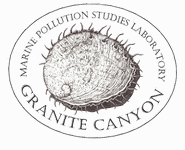
SWAMP IQ: Toxicity Overview
Chemical analyses are a vital component of water quality protection, but these tests only provide part of the picture as they cannot determine the impacts of unknown pollutants or pollutant combinations. That role is fulfilled by toxicity tests. The word "toxicity" refers to the negative impacts of pollutant combinations on aquatic life. These combinations have the ability to produce both lethal (“acute toxicity”) and sublethal (“chronic toxicity”) effects in organisms.
Toxicity tests are typically conducted by exposing laboratory-reared organisms to a water or aqueous sediment sample for a set amount of time, and comparing the resulting effects to a control. The significance of the toxic effect(s) is then calculated using either a hypothesis test or point estimate.
Quality Assurance and Quality Control
Answering any research question with a high degree of confidence requires high-quality data. Studies that produce low-quality data undermine project goals and can result in lost time and money. Therefore, it is crucial to ensure data usability through good quality assurance (QA) practices.
QA is comprised of an integrated system of management activities that are developed during the planning phase of a project. These activities are typically detailed in a QA plan that includes quality control (QC) requirements and corrective actions for field collections and laboratory analyses.
Sample Collection
Obtaining samples for toxicity tests requires standardized sampling and handling procedures. In order to reduce the potential effects of sunlight, air exposure, and heat, samples are typically collected in amber-colored glass bottles that are then capped and preserved in ice before they are transported to the laboratory.
Field QC
QC begins in the field. During sample collection, field blanks, bottle blanks, and sample duplicates are often used to ensure precision and detect bias.
- Field blanks consist of an analyte-free media comparable to the sample of interest (i.e. laboratory water and control sediment), and are carried to the sampling site, exposed to the sampling conditions, returned to the laboratory, and treated as a routine environmental sample.
- Bottle blanks consist of an analyte-free media that is added to a bottle type identical to those used for the environmental samples.
- Sample duplicates are collected at the same time and location as that of the original field sample(s), while using the same sampling protocol.
Laboratory QC
QC is equally important in the laboratory, where negative controls and reference toxicants are used.
- Negative controls, consisting of a sterile form of the environmental sample, are used to measure potential toxicity. Additional negative controls may be used when sample parameters, such as salinity or pH, are outside acceptable ranges.
- Reference toxicant tests utilize a known quantity of a reference material, such as copper sulfate, to evaluate test organism responses. These positive controls assess precision and overall laboratory performance.
Contact Information
For questions regarding toxicity data, please email:
Tony.Gill@waterboards.ca.gov
Data Management
Data management is another vital component of ambient monitoring that incorporates QA measures such as uniform business rules and data review. These strategies ensure the usability of the data generated for a project.
Learn more on the Data Management webpage.
Resources
Measurement Quality Objectives
In an effort to promote precision and reduce bias, SWAMP has established field and laboratory guidelines for various analytes. Dubbed “Measurement Quality Objectives (MQO),” these guidelines contain both recommendations and requirements for sample collection and laboratory analyses.
- Acute and Chronic Marine Sediment Toxicity Test Methods (updated 5/14/19)
- Acute Marine Water Toxicity Test Methods (updated 5/14/19)
- Acute Freshwater Toxicity Test Methods (updated 5/14/19)
- Chronic Freshwater Sediment Toxicity Test Methods (updated 5/14/19)
- Chronic Freshwater Toxicity Test Methods (updated 5/14/19)
- Chronic Marine Water Toxicity Test Methods (updated 5/14/19)



